I know that we are not supposed to judge a book by it’s cover. But, when I saw the cover for an upcoming game called Granada: Last Stand of the Moors – 1482-1492 from Compass Games I was immediately drawn in and wanted to know more. The game is on a subject that I know very little about but definitely is one of interest. So I reached out to the designer Jose and asked if he would want to talk about the design. He agreed and we are now able to bring this interview to you.
As a side note, we also were able to set up an interview with the game’s artist Iván Cáceres and published that on the blog a few weeks ago. Here is a link to that interview: https://theplayersaid.com/2020/03/03/interview-with-ivan-caceres-wargame-graphic-design-artist/
*Please keep in mind that the artwork and layout of the component pictures used in this interview are not yet finalized. Also, as this game is still in development, components and card details may still change prior to publication.

Grant: First off Jose please tell us a little about yourself. What are your hobbies? What’s your day job?
Jose: I come from the Canary Islands and I live in Gran Canaria. However in my twenties I lived for several years in a few European countries to learn foreign languages and new cultures. I studied business administration and hotel management. I worked for the Hotel Industry many years and at present I work on my own renting holiday lodgings in Gran Canaria. My hobbies are travelling, learning languages, reading about Art & History and boardgaming. I entered into game design as an amateur in 2009 and since then I have designed many prototypes (wargames and eurogames).
Grant: How did you get into game design? What do you love most about it?
Jose: I got into game design for a challenge. I joined Labsk the most popular games Forum in Spain and one Spanish designer asked for themes for one of his future game designs. He liked my proposals and ideas so much that he asked me why I didn’t start designing a game, and so I did. What I really love about game design is distilling a period of history, no matter if a battle or a relatively long period, into only several hours of play. Creating a 100% thematic game and with some imagination the game makes you transport yourself to another era and you live it and enjoy it as a small time machine. That’s what fascinates me about game design and playing games with a good theme.
Grant: What is your design philosophy?
Jose: The game has to tell you a story, it should be easy to learn, a big amount of interaction, players should have tension and interest every turn (with nail-biting moments) and medium game play length (2 to 4 hours).
Grant: What do you find most challenging about design? What do you do really well?
Jose: The perfect combination of making a game that works together and keeping the interest and fun for the players from the beginning until the end. For the second question I would prefer that you would ask players what they think but I do try to transmit well the history represented in the games.
Grant: What designs have you completed and what lessons have you learned about finishing a design?
Jose: There are some game designs that I have worked on with just a few being published or going to be. These are just a selection of my designs:
 Congo River 1884, Libertadores, 218 BC Hannibal, Pacificum 15XX, Berlin 1945, Viking Age, Polynesia 700 AD, Monachus, Al Andalus, Granada, etc.
Congo River 1884, Libertadores, 218 BC Hannibal, Pacificum 15XX, Berlin 1945, Viking Age, Polynesia 700 AD, Monachus, Al Andalus, Granada, etc.
There are many projects that in theory seem to be fun and work great but for some reason fun is lost along the way. Therefore one of my goals is that players must have to make several decisions in one turn and should not be able to carry out everything they want to do in order to create some tension and interest during the process. On the other hand though the number of decisions should not be too many such that they become overwhelming and you lose the fun playing the game becomes rather a stressful effort.
Grant: What historical period does your upcoming game Granada cover?
Jose: It covers the last Campaign of the Reconquista from 1482 to 1492, the fall of the last Muslim Kingdom in the Iberian Peninsula (modern Spain and Portugal). A very interesting period not only for the history and future of Spain but for Europe as well.
Grant: What did you feel was important to model in the game from the period?
Jose: To portray the continuous pressure applied by the Christian kingdoms, slow but sure, suffocating the Nasrid kingdom both economically and militarily. Also the lack of union and civil war between Muslim factions because of the cult of power and finally the war model of the time, based mainly on wear, devastation, provocation of fear and sieges.
Grant: What challenges did the design present you with?
Jose: The appropriate distribution of the factions involved. The design of the board and the distribution of important locations and roads. I did not want a simulation but I wanted the game flow to be as faithful to the historical reality as possible and at the same time that both sides had the ability to win.
Grant: What games inspired your thoughts on the design?
Jose: Sekigahara: The Unification of Japan designed by Matt Calkins and published by GMT Games was my main source of inspiration. For me it is one of the best wargames ever designed.
Grant: What sources did you consult on the history? Which source would you recommend as a must read?
Jose: I read a lot to soak up this wonderful history and the more I read the more I was excited. I’m still collecting more books about it. The War for Granada is as if it were a non-fiction Game of Thrones. Most of the books and novels I read are in Spanish, these for example La Guerra de Granada both books by Ladero and magazin Desperta Ferro, El mercenario de Granada, El Último Súspiro del Rey.
 But in English these are the best I found and I can recommend Granada 1492 by Osprey, The Moor’s Last Stand by Elizabeth Drayson and Chronicle of the Conquest of Granada by Irving Washington.
But in English these are the best I found and I can recommend Granada 1492 by Osprey, The Moor’s Last Stand by Elizabeth Drayson and Chronicle of the Conquest of Granada by Irving Washington.
Grant: What different faction do the units represent?
Jose: For the Christian side there are four factions and they represent unified Christian Kingdoms, Castile, Leon, Aragon and Other Kingdoms (representing a mix of Kingdoms with less manpower presence such as Naples, Sicily, Galicia, Basque provinces, etc.).
For the Muslim side there are four factions representing main clans or tribes: Banu Bannigas, Zegries, Banu Sarray & Andalusies. There were many more important clans from Andalusí, Berber or Arab origin but I had to reduce them to some of most significant of Granada at that period.
Grant: Can you show us the map and describe the area represented? What is it’s scale?
 Jose: The map represents the Kingdom of Granada and the Castillian provinces which bordered it. Basically most of Andalucia, Murcia and a part of South Castile. In the map the Mediterranean Sea and a small part of North Africa is also represented. It is hard to say the scale and the board has been developed from several ancient maps and measured scales do not correspond to the current ones.
Jose: The map represents the Kingdom of Granada and the Castillian provinces which bordered it. Basically most of Andalucia, Murcia and a part of South Castile. In the map the Mediterranean Sea and a small part of North Africa is also represented. It is hard to say the scale and the board has been developed from several ancient maps and measured scales do not correspond to the current ones.
Grant: Why did you feel point to point movement was the most appropriate for the design?
Jose: It is the system that best adapts to represent the type of army movements and to limit displacements and communications in order to create short and medium term strategies. Also to better block the roads to the main locations.
Grant: What are Resource Locations and why are they important?
Jose: Resource Locations are an abstract way to represent important towns which had a key value for being handicraft, textile, agricultural or trade centers. These locations provided wealth to the Kingdom.
Grant: What role do cards play in the design?
Jose: Cards in this game are Gold as I like to say. Every single card has importance and can be used in 4 different ways. One use is for bidding for initiative every season. The second use is for movement, third use is for combat or anything related to combat and defense, and the fourth use is for Sea areas.
Grant: How do you determine the number of cards each player receives?
Jose: One player receives 6 cards each season and the player who controls more castles receives 7 cards. One card every season makes a difference.
Grant: Why is there a shared Naval Deck and why did you make this choice?
Jose: There is a shared Naval Deck because Naval combats are different from Field battles. Every time a fleet enters in a Sea area with enemy fleets present there is a chance that a naval combat takes places. That is the use of the Naval Deck.
Grant: Can you show us some examples of a few cards and explain their use?
Jose: Most of the cards in the game has from two to four uses. First bidding for initiative number, second for movement purposes, third for field combat and fourth for naval combat. Please notice that these are not final Art cards and the numbers might change.
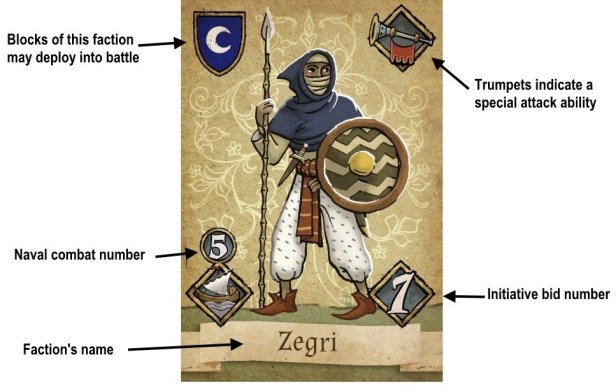
Faction cards. Those are the most numerous in the deck. They have a soldier and a shield which identify them with blocks on the board. Then for example with the first card Andalusi a player may deploy one block of that faction into combat in a location where there are stacks of blocks of both players. Furthermore as that card shows a trumpet it can make a special attack with cavalry, crossbowmen or artillery. The same with the other card showing a soldier of Castile.
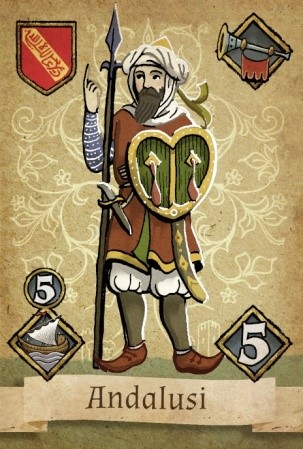
Then there are special cards like Cavalry Charge, which allows a player to deploy into combat any of his four factions blocks with the cavalry bonus. This is an important card to have.
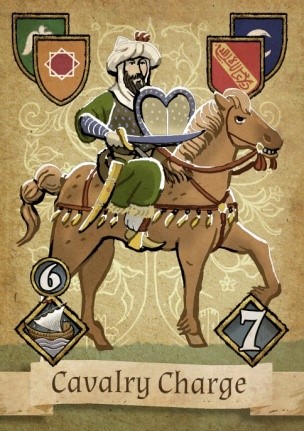
The most powerful card is the Commander as first allows to deploy not only any faction but a special attack, either cavalry, crossbows or artillery. Furthermore it has the higher value for initiative bidding. This card can be used to avoid a battle and retreat without loses and also to deny a challenge for Morale.
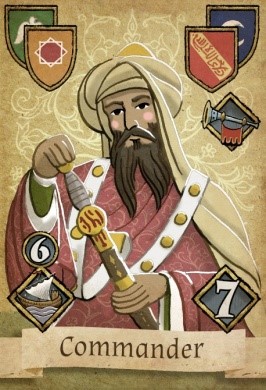
Other useful cards for defense are the Watchtowers which provide +4 impacts in a combat for the player who controls the tower of that location.
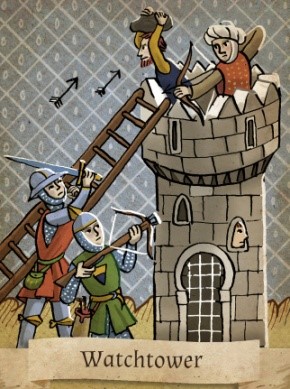
The Morale card can prevent one of the enemy blocks from entering combat which is rather painful if you really need those troops to win the battle.
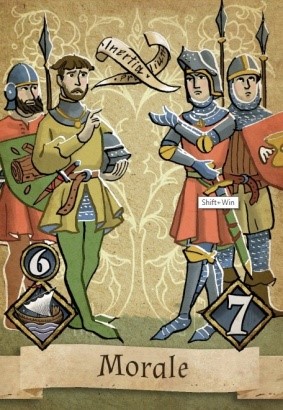
Naval Cards, the first one shows that there will be a naval battle among fleet blocks located in the same sea zone, and the second card shows that there is a Quiet Crossing. Naval battles are streamlined when compared to land battles. Players just select one of the cards in their hands and show them at the same time, with the higher Naval combat number winning the battle, then one or more fleets will be sunk.
Grant: Due to the fact that this is a Renaissance period war there are many weapons including cross bowman and cavalry. How did you integrate these weapons into the design?
Jose: Yes, because infantry impact was not the same as crossbowmen or cavalry. Therefore that different measure of power during combat has to be highlighted somehow and make a distinction in the game units (blocks). Some provide extra power but only if you have the right card to deploy them. Also some blocks are good for field combat and useless in sieges and the other way around.
Grant: How does combat work in the design?
Jose: In my opinion this is one of the most elegant parts of the game as there are no dice used. Some people love dice rolling and I think wargames without dice are really challenging for a designer. No matter how many blocks you have in a location, the players must have the same faction card as shown on the block in order to deploy it into battle (exception for some special cards). Therefore you may have say 8 blocks in the stack but due to the cards in your hand only 4 can be deployed. Each deployed block adds its shield as hits. Every new block that repeat shield, that is from same previous faction deployed add a bonus of 1, cavalry and crossbow also adds +2 hits. For every 7 hits one enemy block is eliminated and the loser of the battle eliminates one extra block. Basically similar combat system as used in Sekigahara with same changes for sieges mainly. The good thing is that in this game you can never take the victory of a battle for granted, a victory can be achieved even if you have a lower number of blocks than the enemy, since the attacker may not have the necessary cards to deploy those blocks so the uncertainty is great and that creates excitement in every single battle.
Grant: What special attacks are available and how are they initiated?
Jose: There are 3 kind of special attacks, one for the crossbowmen, one for cavalry and one for bombards (artillery). These special attacks can be executed when the player has faction cards with trumpets, crossbow and cavalry charge or the commander card. For the Christians there are also bombardment cards used for sieges.
Grant: What role do Castles, Watchtowers and Ports play? What benefits do these elements provide?
Jose: There are 11 locations with Castles (including Alhambra Castle) and those are the most important places of the game, the ones which provide more victory points and one extra card each turn for the player who has more. Castles are hard to take as up to two blocks can get into them and avoid combat then they only can be taken by siege. Also Castles provide one extra move for stacks leaving from them.
Wachtowers also provide victory points at the end of the game but less than Castles. Besides that they have two interesting defensive values, one they avoid overrunning from enemy bigger stacks, second there is one card that can be used in a friendly Watchtower which adds 4 hits to the enemy in combat.
Ports are important as players may move and disembark troops (blocks) in Ports , the South Coast is divided into 9 sea zones. Also besieging a Castle located in a Port location is harder.
Grant: How do sieges work?
Jose: Sieges have a chart to indicate how tough is to get a castle. If in a field combat 7 hits are required to eliminate a block while in a siege 9 hits are required, and if the castle is located in a location with port then 10 hits are required. However artillery is the weapon that reduces the defense of the castle and eliminate blocks with less hits. Have a look at the chart below to better understand.

It is important to clarify that only 2 blocks can defend inside the castle. As soon as these two blocks are eliminated the castle is taken and marked with corresponding players color marker. During the siege combat the attacker discards cards to deploy blocks, the only thing the defender can do is to deploy one artillery block to reduce the attacker’s hits. For this reason, artillery is of great importance for both the attacker and defender during sieges.
Grant: Naval operations are also important. How do naval operations work?
Jose: Yes, naval operations can give an unexpected turn to the war, as players have several fleets during the Campaign and with the fleet they can take these following actions: transport land blocks from port to port, blockade locations with castles, trigger naval battles and make bombardments to coastal locations.
A player may choose to move his fleets instead of taking a land movement. Fleets can move up to 3 sea zones, but as soon as fleets enter a zone with enemy fleets a combat may take place. There is a deck for naval encounters. The active player draws one card if Quiet Crossing then nothing happens and he may continue moving his fleets, if Naval Battle then both players must select one card from their hand for the battle each card has one number with a ship icon, which will determine the winner of the battle. Quick and simple but fun.
Grant: What is the general Sequence of Play?
Jose: This is the Sequence of Play:
A. Turn Order Step . Here players bid for initiative with cards.
- Turns I and II. First the player with initiative moves and engages in combat, then the other player moves and combats.
- Reinforcement Step. Each player receives new cards and blocks. First they discard half (rounded down) of their hand and then take 6 or 7 new cards from the individual deck. Both players draw new blocks from the bag and place them in the recruitment box to be mustered during movement phase.
- Turn Marker Step. Move the turn marker to following season.
Grant: What role does Leadership play and what advantages does it offer?
Jose: Three elements provide Leadership including a Leader, a castle, or a capital. Basically what it offers is one free extra movement for the stacks. In this game, one additional movement is really important to reach one strategic location. Not to confuse with the advantages that one Leader block provides in combat. The Leader block can be deployed first without using a faction card. Also leaders are immune to Morale Challenges.
Grant: What are the strategic choices available to the Catholic player? How should they go about their campaign?
Jose: The Christian player has to be aggressive, he has no time to lose, the more he delays the combats and sieges the better for the Muslims. He has to organize attacks from different parts of the Nasrid Kingdom borders and from the sea to seize coastal locations. Trying to catch Boabdil is important to trigger the civil war and weaken the Muslims. Christians have more manpower and more artillery and that is the key for them to be successful. It is easier for them therefore to conquer castles. A direct and quick blow to Granada Capital is tempting but it would need to gather too many blocks and in the meantime the Muslims can make counter attacks in the unprotected or empty locations. Then it is better to strangle the kingdom by several parts gradually. Also the Christians have to organize their armies in a way they can support each other (pairing them, at least), because the map is large and one isolated army on the periphery of the Muslim Kingdom can do little, regardless of how big it is.
Grant: What are the strategic choices available to the Nasrid player? How should they go about their campaign?
Jose: Muslims have to determine their priority areas on the map, to select which locations to defend during the first turns of the game and stick to it as long as they are in danger. They have not enough armies to stop all fronts in a successful way. The best locations to defend are the ones toward which there is only one attack road, while they can be defended from 2 or 3 roads, allowing the defender to launch an efficient counter-attack. In other terms, the Muslims must take maximum advantage of their location in the center of the map.
Muslims must also make a very clever use of Watchtowers to slow down the advance of Christians and try to defend the key castles until death as it is really hard for Muslims to retake castles by siege.
A good use of fleet is to make obstacles for naval attacks is important. Also knowing when to retreat and leave a location to save a more vital one. From time to time they must provide a blow into the Christian borders when they least expect to distract attention and stop the advance towards Alhambra.
Grant: How have you designed balance into the game?
Jose: Balance is the cornerstone of any game and getting the right balance is thus the Gordian Knot for every designer. With adjustments here and there (blocks power, cards, etc.) I have been gradually tuning the balance to an optimal stage where both players have similar possibilities to win. Still, and due to various historical reasons, I gave some advantages to the Christian player. Also I included several optional rules to provide certain advantages to either side at player’s discretion.
Grant: How are Victory Points earned and what are each sides victory conditions?
Jose: Victory points are earned by controlling locations with Castles, Watchtowers and resources. The interesting issue here is that not only type of locations score different VP but that also Muslim scores higher than Christian for each type of location. That is a method to force the Christian player to be more aggressive to conquer land from Granada Kingdom. Sudden Victory can also be achieved if Granada-Alhambra is conquered or if both Catholic Monarchs are eliminated in combat.
Grant: What are you most proud of with the design?
Jose: The bluffing element which is key for planning and strategic decisions. The incorporation of special locations that are used in connection with special cards to each combat adds lots of uncertainty which reflects well the outcome of the battles thus creating tension all the time. The players have to focus continually on many fronts to cover and many fires to stop and will never have enough manpower to make all they wish to accomplish, therefore priorities have to be determined.
Also seeing how the history of the campaign unfolds below your eyes all over the map scenario gaining or losing terrain is very exciting.
Grant: What has changed through the playtest process? Please give a few examples.
Jose: Any game has to go through testing and every trial session provides signs of how well the game is performing and where it lacks or needs tweaks to improve. The changes done to Granada have been in roads, new road links or changing old ones on the map to create more interesting or challenging circumstances. Set up has also seen a few changes, by adding more blocks here, less blocks in that location. Blocks also, whenever I felt a side had disadvantage I added some more faction blocks. Tiny changes in cards. Changes in movement and stacks limitations. Also in Naval combat to simplify the process. Even the turn track was reduced to shorten the game play. Basically those adjustments have been done to make the final game flow better.
Grant: What other games are you currently working on?
Jose: I am working presently on 218 BC Hannibal (the 2nd Punic War) and The King in the North (1st Carlist War 1833-1840). I have a couple of ideas for other wargames but will wait to announce those at a later stage.
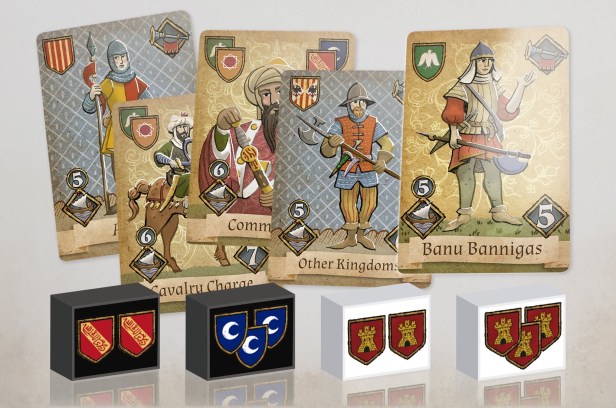
Thanks for your time in answering our questions Jose. We have appreciated the look inside the game and I can see that there is more than a “pretty face” here. I am really looking forward to that one as we loved our plays of Sekigahara and I am interested in the history here as well.
If you are interested in Granada: Last Stand of the Moors – 1482-1492 you can pre-order a copy for $64.00 from the Compass Games website at the following link: https://www.compassgames.com/preorders/granada-last-stand-of-the-moors-1482-1492.html
-Grant
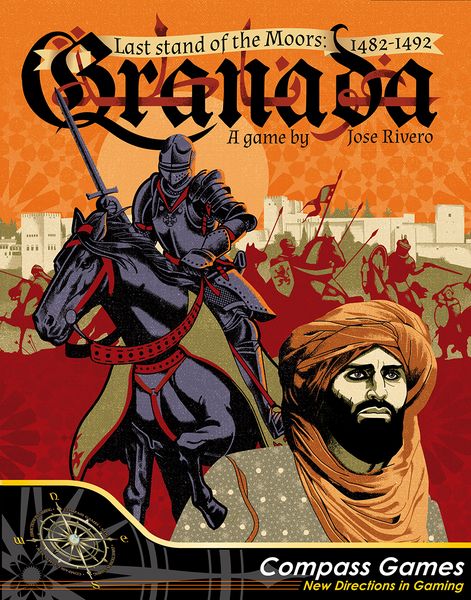










Seriously one of the most beautiful games I’ve ever seen. CAN. NOT. WAIT. FOR. THIS.
LikeLiked by 1 person
What a post! This is so chock full of useful information I can’t wait to
dig deep and start using the resources you’ve given me.
King regards,
Mead Duke
LikeLiked by 1 person
Great interview with Jose. This game looks outstanding. Ordered a copy from Compass Games.
LikeLiked by 1 person